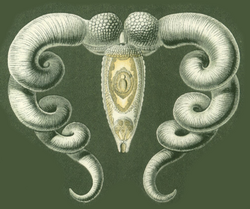Biology:Bucephaloidea
| Bucephaloidea | |
|---|---|

| |
| Bucephalus polymorphus larva | |
| Scientific classification | |
| Domain: | Eukaryota |
| Kingdom: | Animalia |
| Phylum: | Platyhelminthes |
| Class: | Trematoda |
| Order: | Plagiorchiida |
| Suborder: | Bucephalata La Rue, 1926 |
| Superfamily: | Bucephaloidea Poche, 1907[1] |
The Bucephaloidea are a superfamily of trematode flatworms, belonging to the large group Digenea. Many species are endoparasites of mollusks and fish. The name Bucephalus meaning "ox head" was originally applied to the genus Bucephalus because of the horn-like appearance of the forked tail (furcae) of its cercaria larva. By what Manter calls a "curious circumstance", horns are also suggested by the long tentacles of adult worms.[2]
Most trematodes have several distinct developmental stages. The motile cercaria larva is released by the first intermediate host, typically a snail, and parasitizes a second intermediate host, where it encysts into a metacercaria. Finally, the adult flatworm typically inhabits the alimentary system or other body cavity of a fish.[3]
The families of Bucephaloidea are Bucephalidae and Nuitrematidae.[4]
Family Bucephalidae
Bucephalids are trematode parasites of fish. The intermediate hosts include mollusks and at least one amphibian. One characteristic feature is an anterior rhyncus or holdfast that is separate from the digestive system. They also differ from other digeneans in the configuration of the digestive systems and genitalia.[5]
Family Nuitrematidae
This family was described in 1975 by Kurochkin. It has many features similar to the bucephalids, but the body is sharply subdivided in two parts.[6] The family is monotypic; it contains only one genus, Nuitrema.
References
- ↑ Poche, F. (1907). Einige Bemerkungen zur Nomenklatur der Trematoden. Zoologischer Anzeiger, 31, 124–126.
- ↑ Manter, H. W. (1940). "Digenetic trematodes of fishes from the Galapagos Islands and the neighboring Pacific". Reports on the Collections Obtained by Allan Hancock Pacific Expeditions, 1932-1938 2 (14): 333. http://digitalcommons.unl.edu/cgi/viewcontent.cgi?article=1667&context=parasitologyfacpubs. Retrieved 20 February 2011.
- ↑ "2. FISH DISEASES (Contd.) 2.1.4 Parasitic Diseases". FAO of the UN Food and Agriculture Organization of the United Nations. http://www.fao.org/docrep/field/003/ac160e/AC160E03.htm. Retrieved 18 February 2011.
- ↑ "WoRMS taxon details: Bucephaloidea". WoRMS. http://www.marinespecies.org/aphia.php?p=taxdetails&id=108414. Retrieved 18 February 2011.
- ↑ Gibson, D. I. (2002). Keys to the Trematoda. CABI. pp. 67. ISBN 0-85199-547-0. https://books.google.com/books?id=zv6kcB30vMIC&q=bucephaloidea&pg=PA67.
- ↑ Gibson, D. I. (2002). Keys to the Trematoda. CABI. pp. 96. ISBN 0-85199-547-0. https://books.google.com/books?id=zv6kcB30vMIC&q=bucephaloidea&pg=PA67.
Wikidata ☰ {{{from}}} entry
 |

